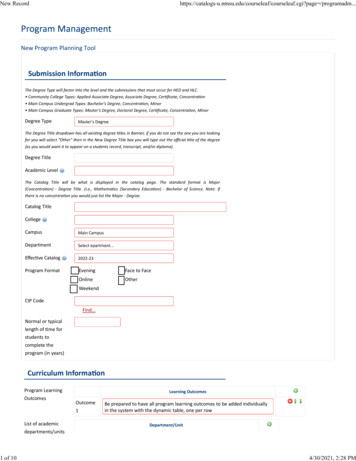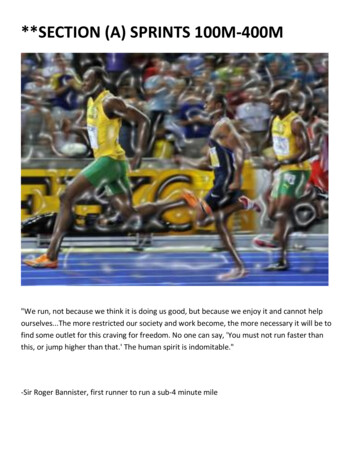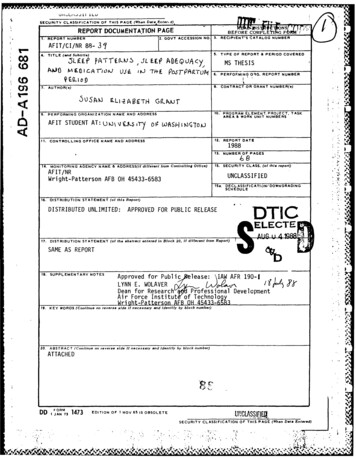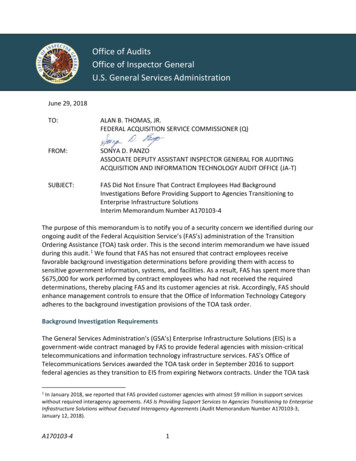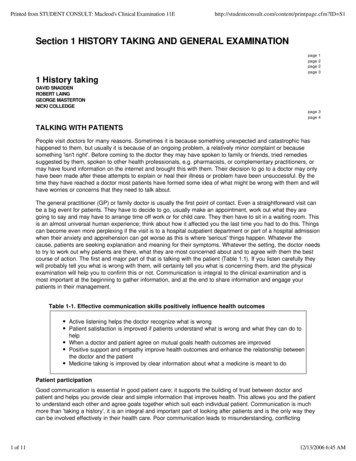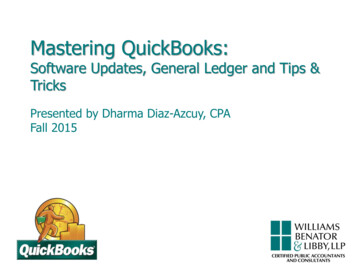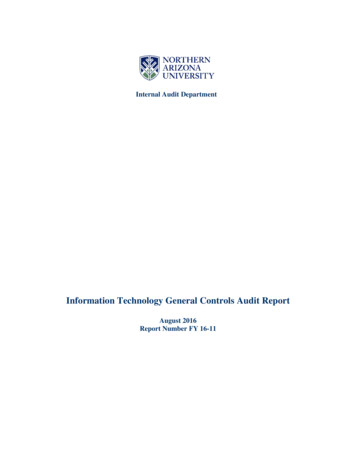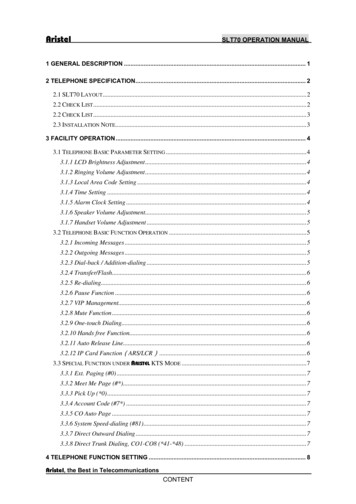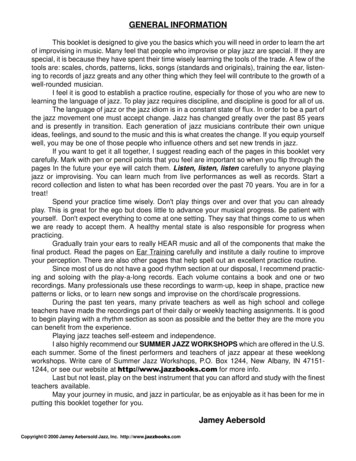
Transcription
GENERAL INFORMATIONThis booklet is designed to give you the basics which you will need in order to learn the artof improvising in music. Many feel that people who improvise or play jazz are special. If they arespecial, it is because they have spent their time wisely learning the tools of the trade. A few of thetools are: scales, chords, patterns, licks, songs (standards and originals), training the ear, listening to records of jazz greats and any other thing which they feel will contribute to the growth of awell-rounded musician.I feel it is good to establish a practice routine, especially for those of you who are new tolearning the language of jazz. To play jazz requires discipline, and discipline is good for all of us.The language of jazz or the jazz idiom is in a constant state of flux. In order to be a part ofthe jazz movement one must accept change. Jazz has changed greatly over the past 85 yearsand is presently in transition. Each generation of jazz musicians contribute their own uniqueideas, feelings, and sound to the music and this is what creates the change. If you equip yourselfwell, you may be one of those people who influence others and set new trends in jazz.If you want to get it all together, I suggest reading each of the pages in this booklet verycarefully. Mark with pen or pencil points that you feel are important so when you flip through thepages In the future your eye will catch them. Listen, listen, listen carefully to anyone playingjazz or improvising. You can learn much from live performances as well as records. Start arecord collection and listen to what has been recorded over the past 70 years. You are in for atreat!Spend your practice time wisely. Don't play things over and over that you can alreadyplay. This is great for the ego but does little to advance your musical progress. Be patient withyourself. Don't expect everything to come at one setting. They say that things come to us whenwe are ready to accept them. A healthy mental state is also responsible for progress whenpracticing.Gradually train your ears to really HEAR music and all of the components that make thefinal product. Read the pages on Ear Training carefully and institute a daily routine to improveyour perception. There are also other pages that help spell out an excellent practice routine.Since most of us do not have a good rhythm section at our disposal, I recommend practicing and soloing with the play-a-long records. Each volume contains a book and one or tworecordings. Many professionals use these recordings to warm-up, keep in shape, practice newpatterns or licks, or to learn new songs and improvise on the chord/scale progressions.During the past ten years, many private teachers as well as high school and collegeteachers have made the recordings part of their daily or weekly teaching assignments. It is goodto begin playing with a rhythm section as soon as possible and the better they are the more youcan benefit from the experience.Playing jazz teaches self-esteem and independence.I also highly recommend our SUMMER JAZZ WORKSHOPS which are offered in the U.S.each summer. Some of the finest performers and teachers of jazz appear at these weeklongworkshops. Write care of Summer Jazz Workshops, P.O. Box 1244, New Albany, IN 471511244, or see our website at http://www.jazzbooks.com for more info.Last but not least, play on the best instrument that you can afford and study with the finestteachers available.May your journey in music, and jazz in particular, be as enjoyable as it has been for me inputting this booklet together for you.Jamey AebersoldCopyright 2000 Jamey Aebersold Jazz, Inc. http://www.jazzbooks.com
VALUABLE JAZZ INFORMATIONby Jamey AebersoldThe basic ingredients in music are SCALES, CHORDS, MELODY, RHYTHM, and HARMONY. Jazz education's purpose is togive you the basics you need in learning to play jazz or to improvise. The jazz musician is an instant composer! The melodies whichcome from their instruments are conceived in their mind just before they play them. The difference between the improviser and thetraditional composer is this: that the "jazzer" has no eraser to instantly correct mistakes. They practice long and hard trying to make theirphysical body and their mental frame of mind an appropriate vehicle to execute the ideas formulated in their mind.The GOAL of every jazz musician is to play on their instrument (or vocally sing) what is heard in their mind. Practicing scales,chords (arpeggios), exercises in all keys will help gain facility which will help unlock the ideas that are now being held prisoner in yourmind. As soon as possible, try playing what you HEAR mentally in your head! In other words, sing a short melody mentally, or sing withyour mouth, and then play those exact pitches and rhythms on your instrument. This is the same procedure the jazz player uses whenimprovising.To play requires discipline. It is good to establish a practice routine. Improvisation should be a part of your daily practice. Playwhatever you hear in your head. It could be something from TV, radio, or just some melodies that you hum to yourself. This is also a formof EAR TRAINING. You are training your inner ear to direct your fingers to the notes it hears, instantly. Gradually train your ears to reallyHEAR music and all of the components that make the final product. Listen carefully to anyone playing jazz or improvising. You can learnmuch from live performances as well as records and tapes. Start a record collection and listen to what has been recorded over the past70 years. Write for FREE "Double-Time" Jazz discount catalog, P.O. Box 146, Floyds Knobs, IN 47119-0146.The old myth that says, "You either have it or you don't," is strictly a myth founded on ignorarice and the inability (or unwillingness) of those who can play to share what they do verbally with those who think they can't learn.The mind is the originator of ALL musical thoughts. The mouth (singing) usually can approximate the pitches, rhythms, andnuances of what the mind hears better than actual instruments (sax, trumpet, etc.) can do. Since the instrument we have chosen is alearned device, it is the least able to reproduce the musical thoughts of our mind. It stands to reason that the person who is betterequipped technically will come closer to playing on their instrument the thoughts of their mind.One of the reasons the jazz greats sound different than you is the fact they have so many sounds (scales, chords, patterns,ideas) at their disposal. The SCALE SYLLABUS can help you uncover new sounds. Practicing, using the exercises found in this bookletor in Vol. 1 “How To Play Jazz And Improvise” will give you a good foundation to play ANY style of music.“JAZZ IS FREEDOM!” Thelonious Monk said this. Too often we refuse to take advantage of an opportunity which will allow usa measure of growth and freedom in our musical expression. Listening to jazz greats is inspirational and rewarding. Keep this in mind:practicing exercises, patterns, licks, scales, and chords should lead to more expressive creativity, not boredom.HOW DO YOU BEGIN IMPROVISING? Many people begin by playing by ear (letting their inner musical ear guide their choiceof notes and rhythms). This is a hit-or-miss process that most jazz players (before 1965) had to use to learn their trade. However, thismethod strengthens the player’s ear and is extremely valuable. Everyone should spend time each day playing by ear. The sooner youtrain your ears to discern, the sooner they can HELP YOU in making music. By using your ear, and knowledge of the needed scales andchords, you will feel much more comfortable with beginning improvisation.IMPORTANT: Don't get hung up practicing exercises and more exercises without ever attempting to improvise. Avoid becominga person who plays great exercises, but delays using their creative energy until tomorrow . DO IT NOW! -- IMPROVISE. Even if you onlyuse a few notes of the scale, begin right there. START! Don't put it off until tomorrow or until you have the scale under better control. DOIT NOW! The longest journey begins with a single step. Today is the first day of the rest of your life. The longest musical phrase beginswith a single note.Just because you practice scales, chords, patterns, and exercises doesn't mean you will sound stiff and mechanical, OR thatyou will become a jazz great! But it’s a means to an end. More than any other ingredient, the JAZZ TRADITION is based on LISTENING.Listening to jazz records/tapes should be part of every musicians daily routine. Not only is it fun to listen to, but you can absorb manymusical ideas and incorporate them into your own solos. Recorded music contains most answers you seek.Having "good ears" means having the ability to hear the roots to the various chords or scales that are being played; having theability to hear the quality of the chord or scale--major, minor (what kind of minor?), pentatonic, dim.whole tone, etc.); it means having theability to tell what tone of the scale or chord is being played at any point in the solo--"ah, that note was a #4 resolving to the 6th and thenresolving to the 5th!"; it means hearing the piano, bass, soloist, drums, etc. individually as well as collectively.There are many levels of hearing. Some people hear. Other people can really HEAR! And some can seem to hear and identifyalmost anything that is being played. They can seem to sing or play back portions of solos right after the performer has played. How canthey HEAR, and we can't seem to find the roots, scale, qualities, or what time signature the piece is in? They have worked hard atidentifying all the various sounds they hear daily. Since they want to improvise, they take the time to apply on their instrument the thingsthey are hearing. They also use their mind and their free time to figure out things harmonically, melodically, and rhythmically. Using asmall chromatic pitch pipe is real helpful in identifying pitches when you are not at a piano or don't have your instrument. You can carryit with you and train your ear "on the go." No one knows or could truly imagine the amount of thought each jazzer has put into their art/craft.PRACTICE SUGGESTIONS1 . Play with good sound/tone. Wind players -- support your sound. Don't play staccato.2. Make phrases flow naturally; even when playing scales and exercises.3. Mentally sing the exercises, scales, patterns as you play them.4. If an exercise is hard, slow it down. Then gradually increase the tempo.5. Listen to every note you play. Match your mind’s ideas.6. Be patient. You're not the first to make mistakes.7. Use jazz articulations on exercises and scale/chord practice.8. Improvise some every day. That's the REAL YOU. Play what you hear in your head.9. Make a habit of practicing in all twelve keys. Volumes 21 and 24 are excellent.10. Learn the Blues in Bb & F concert keys.11. Memorize everything you can. Know what it is you are trying to play.If we all waited until we were perfect musicians before we played an instrument, there would be no music in the world. . Play onthe best instrument you can afford and study with the finest teachers available who will give you guidance in jazz and traditional music.Use your imagination. Experiment- take chances! You deserve to be creative! Treat yourself.Copyright 2000 Jamey Aebersold Jazz, Inc. http://www.jazzbooks.com
Soloing: by Jamey Aebersold1. Keep your place - don’t get lost. If you do get lost LISTEN to the rhythm section. The drummerwill often give a little crash at the beginning of new sections. If you hit a note that is not what youintended, move it up or down a half-step and you’ll probably be back in the scale (or chord).Remember, jazz music usually moves in two, four and eight bar phrases. You’re never far from anew phrase beginning.2. Play right notes. This really means play the notes you hear in your head.the notes youwould sing with your mouth. Having the scales and chords in front of you on a piece of paper ismerely a guide. They don’t provide the actual music that’s going to be played. THAT comes fromYOUR imagination. If you’ve got the scales, chords, and chord/scale progression MEMORIZEDit provides courage to your imagination and allows you to operate from a more creative naturalbasis. It allows you to take some chances. It helps remove FEAR.3. Using REPETITION and SEQUENCE is natural in music. It’s found in all types and styles ofmusic. The novice improvisor often feels that if they repeat an idea, everyone knows they aregoing to repeat it, so why do it; plus it’s not original enough for your EGO so you don’t play it.WRONG! The listener needs to hear some repetition and sequence or else they can’t rememberanything you play. Repetition and Sequence are the glue that holds solos together. The usualnumber of times something is repeated depends on you but the average is 2 or 3 and then yourmind will tell you when to repeat and/or when to use sequence. It’s a part of the way we hearmusic played by others.4. CHORD TONES (the 1, 3, 5, & 7 of a scale) are great notes to begin and end a phrase with.Just sing a phrase and see if you don’t follow this simple rule. Our ears HEAR chord tones firstso it’s natural to begin and end there. Plus, it gives us and the listener what we’re listening for harmonic stability.5. SOUND: Be sure that you are getting a good, full sound on your instrument (or voice). Don’tlet the scales and chords or the progression or tempo intimidate you. Sound is foremost and isthe FIRST thing a person latches onto when you sing or play. It leaves a lasting impression. So,be yourself and let your voice or instrument ring out. It’s the main ingredient of your musicalpersonality.6. LISTENING: There’s no way anyone is going to play jazz or improvise well without listeningto those musicians who have come before. Through listening alone you can find ALL the answers. Each musician is a result of what they have listened to. It’s easy to det
of EAR TRAINING. You are training your inner ear to direct your fingers to the notes it hears, instantly. Gradually train your ears to really HEAR music and all of the components that make the final product. Listen carefully to anyone playing jazz or improvising. You can learn much from live performances as well as records and tapes. Start a record collection and listen to what has been recorded over the past
